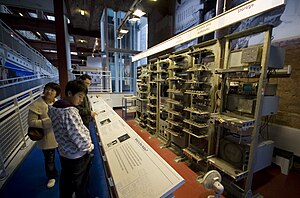Our website is made possible by displaying online advertisements to our visitors.
Please consider supporting us by disabling your ad blocker.
Manchester computers

The Manchester computers were an innovative series of stored-program electronic computers developed during the 30-year period between 1947 and 1977 by a small team at the University of Manchester, under the leadership of Tom Kilburn.[1] They included the world's first stored-program computer, the world's first transistorised computer, and what was the world's fastest computer at the time of its inauguration in 1962.[2][3][4][5]
The project began with two aims: to prove the practicality of the Williams tube, an early form of computer memory based on standard cathode-ray tubes (CRTs); and to construct a machine that could be used to investigate how computers might be able to assist in the solution of mathematical problems.[6] The first of the series, the Manchester Baby, ran its first program on 21 June 1948.[2] As the world's first stored-program computer, the Baby, and the Manchester Mark 1 developed from it, quickly attracted the attention of the United Kingdom government, who contracted the electrical engineering firm of Ferranti to produce a commercial version. The resulting machine, the Ferranti Mark 1, was the world's first commercially available general-purpose computer.[7]
The collaboration with Ferranti eventually led to an industrial partnership with the computer company ICL, who made use of many of the ideas developed at the university, particularly in the design of their 2900 series of computers during the 1970s.[8][9][10]
- ^ Lavington (1998), p. 49
- ^ a b Enticknap, Nicholas (Summer 1998), "Computing's Golden Jubilee", Resurrection (20), The Computer Conservation Society, ISSN 0958-7403, archived from the original on 9 January 2012, retrieved 19 April 2008
- ^ Grimsdale, Dick, "50th Birthday of Transistor Computer", curation.cs.manchester.ac.uk, retrieved 24 February 2018
- ^ "A Timeline of Manchester Computing", University of Manchester, archived from the original on 5 July 2008, retrieved 25 February 2009
- ^ "timeline". 5 July 2008. Archived from the original on 5 July 2008.
- ^ Lavington (1998), p. 7
- ^ Lavington (1998), p. 21
- ^ Lavington, Simon (1980), Early British Computers, Manchester University Press, ISBN 978-0-7190-0803-0
- ^ Lavington, Simon (1998), A History of Manchester Computers (2nd ed.), The British Computer Society, ISBN 978-1-902505-01-5
- ^ Napper, R. B. E. (2000), "The Manchester Mark 1 Computers", in Rojas, Raúl; Hashagen, Ulf (eds.), The First Computers: History and Architectures, MIT Press, pp. 356–377, ISBN 978-0-262-68137-7
Previous Page Next Page


